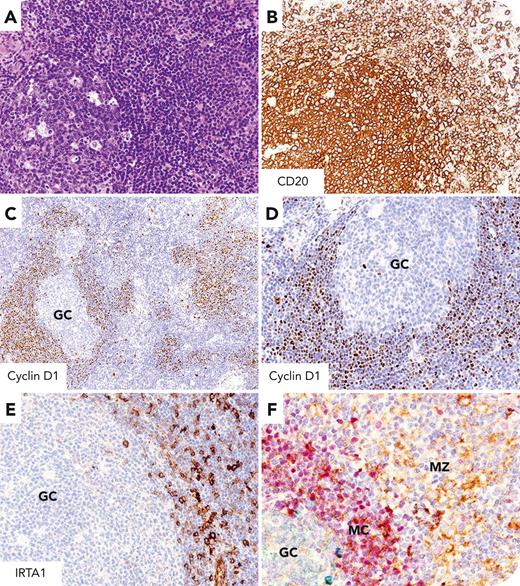A 76-year-old man presented with bilateral neck lymphadenopathies without systemic symptoms. Biopsy of a laterocervical lymph node showed diffuse infiltration by small lymphocytes and residual germinal centers (GCs) surrounded by expanded mantle cells (MCs) and marginal zones (MZs) (panel A, ×200 magnification). The small lymphocytes and expanded mantle cells expressed CD20 (panel B, ×200 magnification), CD5, SOX11, and nuclear cyclin D1 (panel C, ×100 magnification; panel D, ×200 magnification). MZs were made up of IRTA1+ B cells (panel E, ×200 magnification). Ki-67 was <10%.
The case shows the unusual presence of expanded MZ in a mantle cell lymphoma (MCL) raising the question of whether the MZ is neoplastic or reactive. Triple immunostainings for CD10 shown in green (labeling of GC cells), cyclin D1 in red (labeling nuclei of MCL cells), and IRTA1 in brown (labeling B cells of MZ) demonstrate that the MZ was occupied by cells expressing IRTA1 (a specific marker of MZ B cells) and that immunostaining for IRTA1 and cyclin D1 was mutually exclusive (panel F, ×400 magnification). These findings exclude the possibility that the MZ represents a differentiation of MCL. Thus, the final diagnosis was MCL with IRTA1+ reactive expansion of MZ. Positron emission tomography–computed tomography scan showed multiple mediastinal and abdominal lymphadenopathies associated with splenomegaly. The patient was started on bendamustine plus rituximab.
For additional images, visit the ASH Image Bank, a reference and teaching tool that is continually updated with new atlas and case study images. For more information, visit https://imagebank.hematology.org.


This feature is available to Subscribers Only
Sign In or Create an Account Close Modal